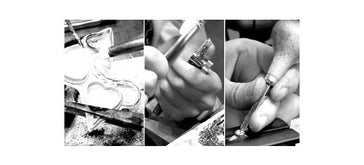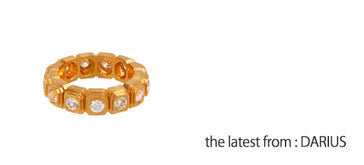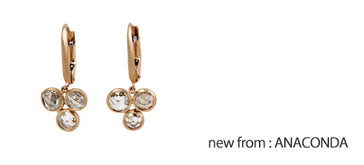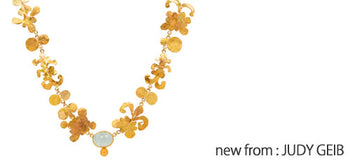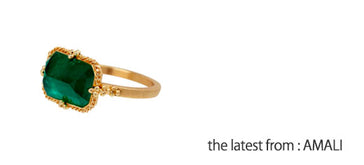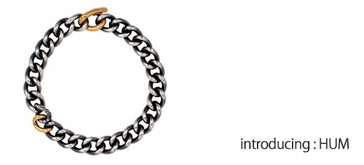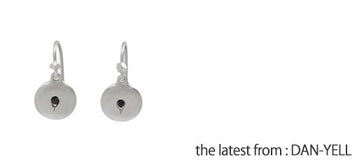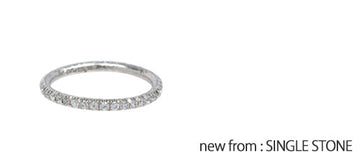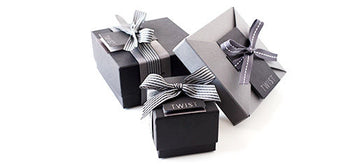Diamonds:
One of the most recognized and treasured of all gemstones, the diamond has universal appeal and significance. Believed to have first appeared in India 4000 - 6000 years ago, the diamond is composed of pure carbon and known to be the hardest substance found in nature.
While the most famous diamonds are flawless and colorless, they are very rare. The largest flawless diamond in the world is The Paragon, a D-class gem weighing 137.82 carats.
Many artists and designers are now using naturally colored and rustic diamonds in their jewelry for their diverse, earthy and sumptuous color and organic characteristics. They are as distinctive as traditional diamonds, but offer a more individual elegance.
the kimberley process:
The Kimberley Process certification system was formally adopted in 2003 and guards against conflict diamonds entering the legitimate diamond trade industry. Many govenments - including the US - have adopted this policy into national law.
All of our artists and designers adhere to this policy and use only conflict-free diamonds in their jewelry.
diamond cuts (these cuts are also used on other precious and semi-precious stones)
brilliant cut diamonds:
This modern cut is probably the most common and recognized diamond cut and one of the most desired for enhancing the play of color and maximizing brilliance.
A brilliant cut consists of 56 - 58 facets. Round, oval, radiant, princess, heart, marquis and pear cut diamonds fall into this category.
The 58 facet cut is divided into the crown (top), girdle (widest portion), and pavillion (base) and is calibrated through a precise formula to achieve maximum color and brilliance.
rose cut diamond:
This unusual cut, becoming more and more popular and distinctive, has been in use since 1520 and was created to resemble an opening rose bud. Rose cut diamonds were the predominant diamond style of Europe from the 16th to 18th centuries.
Basic rose cut diamonds have a flat base with no pavillion and a crown composed of triangular facets (usually 12 or 24) in symmetrical arrangement. The surface usually rises to a point.
The facets on a rose cut diamond are often in two rows - with 'star facets' (usually six triangles) in the center and a proportional number of facets in the second row.
baguette cut diamond:
Long, slender and rectangular in shape, this cut of diamond is named after the French word 'baguette' meaning 'long rod'. It became popular in the 1920's and 1930's and was influenced by the design and architecture of the Bauhaus movement.
Baguettes are normally small in weight and measured in dimensions rather than carats. Ideally, the ratio of length to width is 1.5 to 1. They are usually used as side stones for other cuts of diamonds.
marquis cut diamond:
The marquis cut diamond has a distinctive, elongated shape characterized by the two points on either side of its boat-like shape. This shape can provide the appearance of a diamond with greater weight than it actually is.
This cut is also known as a 'marquis shaped brilliant stone'.
princess cut diamond:
The princess cut diamond, created in the 1960's, combines the high degree of light return of a brilliant cut diamond with the unusual and distinctive shape of a square.
It is usually an inverted pyramid with four beveled sides.
More crystal weight can be retained with this cut.
teardrop cut diamond:
This cut is like an oval with one point - kind of a cross between an oval and marquis shape. The teardrop - also known sometimes as a 'pear cut' - was very popular during the Renaissance period.
Its ideal length to width ratio is 1.5 : 1 and there are usually 58 facets.
emerald cut diamond:
The emerald cut was originally created for the cutting of emeralds and became popular during the Art Deco period.
It is a step-cut and traditionally has 58 facets - 25 crown, 8 girdle and 25 pavillion. The accepted ratio for this shape is 1.5 : 1 to 1.75 : 1.
Because this cut is so open, flaws and color weakness are more evident.
cushion cut diamond:
Softly rounded corners give this cut stone a softness. The shape is also know as 'pillow cut' or 'candlelight cut'. It is a cut combining the shape of an old mine cut stone and a modern oval cut.
There are many variations of this cut and vary from rectangular in shape to more squared.
This cut is more dispersive of color than round brilliant cuts - meaning the light separates into more spectral colors.
oval cut diamond:
This shape - invented in the early 1960's - is also refered to as 'oval modified brilliant'. It often looks larger than a round stone of the same carat weight.

